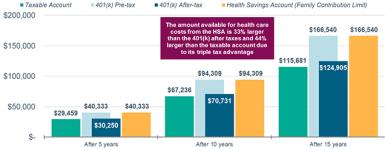Health Savings Accounts: Maximizing Your HSA for Retirement Savings

Please note: This article may contain outdated information about RMDs and retirement accounts due to the SECURE Act, a new law governing retirement savings. The SECURE Act may impact investors nearing- or in retirement, new parents, small business owners and employees. For more information about the SECURE Act, please read this article or speak with your financial consultant.
Are you getting the most out of your health savings account (HSA)?
HSAs give people with high-deductible health plans a tax-advantaged way to set aside money for medical expenses. Contributions are made pre-tax, similar to a 401(k), and you pay no taxes on withdrawals for qualified medical expenses. You can also invest unused balances for potential tax-free growth. (See this article for more on how HSAs work.)
Many people draw money from their HSAs to pay for current medical bills. But that's not the only way to use these accounts. Their tax benefits also make HSAs a potentially valuable vehicle for saving for future bills, particularly in retirement. After all, many people see their health care costs rise in old age. The trick is finding the right balance between your contributions, your withdrawals and your ability to let your savings accrue over time.
Let’s take a closer look.
Tax advantages
As mentioned above, HSAs offer account holders a triple tax exemption:
- no federal income taxes on contributions1
- no federal taxes on investment earnings2
- no taxes on withdrawals for qualified medical expenses3
By comparison, 401(k) retirement plans offer just a double tax benefit—you pay no income taxes on contributions and no tax on investment earnings, but you do pay taxes on distributions in retirement.
That triple exemption can make HSAs a uniquely powerful tool for building a nest egg for future health care expenses.
The chart below shows a theoretical example of how an investor’s savings could accrue in an HSA account versus a regular taxable investment account or a 401(k) plan. Now, this example assumes the account holder contributes the maximum amount allowed for someone with family health coverage every year, invests the entirety of her contributions and makes no withdrawals. Obviously, that wouldn’t work for everyone—it would mean paying all current medical bills out of pocket while leaving the HSA funds to grow tax-free. Most people don’t have the resources or desire to do that.
However, you can see how the savings could accumulate over time. And you don’t need to contribute the maximum amount to get the tax advantages. Smaller contributions or lower levels of investment would still receive the triple tax benefit.
The effects of taxes on different investment accounts
Source: Schwab Center for Financial Research. The chart is for illustrative purposes only. Assumes $5,000 in annual after-tax contributions to a taxable account, or $6,750 in annual pre-tax contributions to a 401(k) or HSA account. $6,750 is the maximum contribution allowed for an eligible individual or any other person with family high-deductible health plan coverage combined with an HSA in 2017. The limit for self-only coverage combined with an HSA in 2017 is $3,400, so the numbers in the yellow shaded boxes would be substantially lower. Assumes annual investment growth of 6% in a diversified portfolio that is 60% stocks and 40% bonds and cash, a 15% long-term capital gains tax annually on earnings in the taxable account, a 25% tax on distributions from the 401(k) and no tax on distributions from the HSA account for qualified health care costs. In practice, you shouldn’t invest HSA funds needed to pay for two to three years of potential out-of-pocket healthcare costs. Past performance is no guarantee of future results.
One other tax-related matter: If you’re under 65 and you spend money from your HSA on non-qualified expenses, you’ll have to pay ordinary income tax on your withdrawals—plus a 20% penalty. After age 65, you’ll just have to pay income taxes.
That makes HSAs a flexible tool for your retirement-savings toolbox: After age 65, qualified withdrawals for medical bills are untaxed, and non-qualified withdrawals are treated like normal income. That makes non-qualified withdrawals a bit like withdrawals from a 401(k) plan or traditional individual retirement account (IRA), but without the required minimum distribution rules that kick in at age 70 ½ for investors with such accounts.
HSAs in practice
Of course, HSAs are just one of the tools in your toolbox, and how you juggle your obligations depends on your plans and financial situation. Your HSA contributions have no bearing on your 401(k) and IRA contributions—you could theoretically contribute the maximum amount to all three if you were able. Not everyone can set that much aside, though. So how do you use your HSA in the face of competing needs?
Here are some guidelines:
- First, contribute at least enough to your 401(k) plan to secure matching funds from your employer.
- Next, you could calculate how much you expect to spend on out-of-pocket medical expenses during the year and contribute that amount to your HSA.
- Then it’s time to consider how concerned you are about future medical expenses. If preparing for future medical bills is a priority, consider increasing contributions to your HSA and investing any unused funds. Obviously, the more you save and less you spend today, the more you’ll have for the future.
- Finally, you could factor in your current and expected future tax rates. If you’re worried that you might be in a high tax bracket even in retirement, it could be helpful to build up tax-advantaged savings just for medical expenses. After all, you will likely have to pay taxes on withdrawals from your 401(k) or traditional IRA (although not a Roth IRA), so being able to tap an HSA tax-free could be a big benefit.
You will also have to decide how to invest your HSA savings (some providers require a minimum balance before investments are allowed). Leaving your savings in cash would help shield you from the risks of the market, but you’d be giving up any potential gains that might come from being invested. Every HSA administrator offers a different selection of investments (usually it’s a selection of mutual funds).
We suggest you keep money you might need for medical expenses during the next couple of years in cash or a liquid, stable investment like a savings account or money market fund within the HSA. After that, consider investments that match your time horizon and risk tolerance, just as you would with any other investment account.
What do to now?
If you’re eligible for an HSA—or have one already—ask yourself if you’re taking full advantage of the tax advantages. Thinking about future medical costs isn’t fun, but preparing ahead of time makes any challenge a lot more manageable.
If you need help, talk to a Schwab Financial Consultant or your employer’s benefit consultant.
1 HSA contributions are not deductible in several states, including California, Alabama and New Jersey. Check with your tax advisor for specific tax advice.
2 State taxes may vary.
3 See IRS Publication 502 for a list of these expenses.
 By
By
